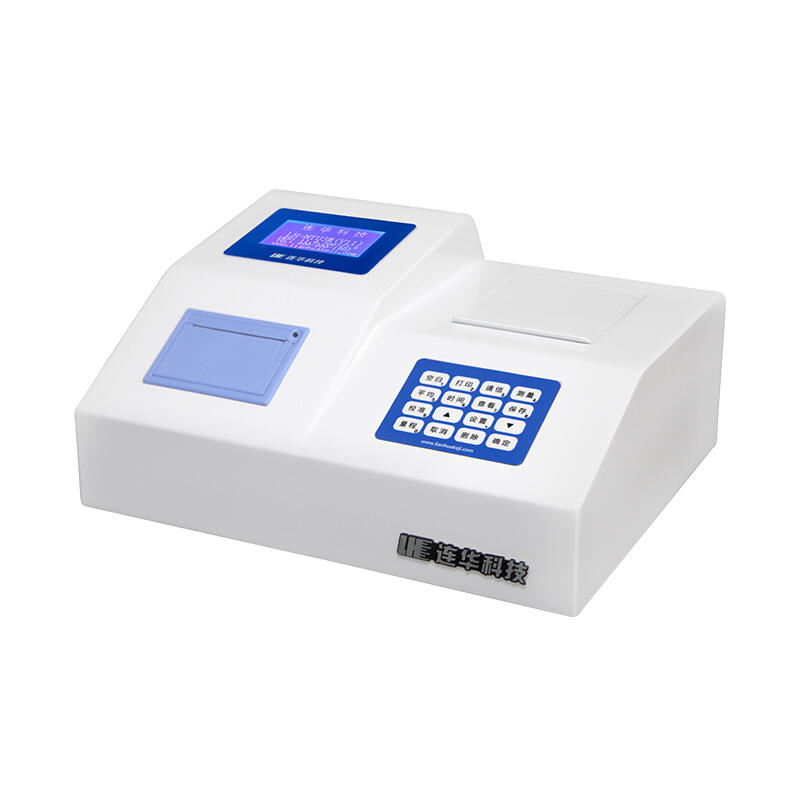How to choose a portable turbidity analyzer to test water quality
Understanding Turbidity and Its Role in Water Quality Monitoring

What Is Turbidity and Why It Matters for Water Safety
Turbidity basically tells us how cloudy water is because of all those tiny particles floating around in it, things like clay, silt, algae, and various organic materials. When turbidity levels get high, water becomes less clear, which makes disinfection processes less effective. What's worse, these conditions can actually become breeding grounds for harmful organisms including E. coli and Cryptosporidium. A recent study from 2022 showed something pretty significant too: whenever turbidity goes up by 10 NTUs, treatment costs jump by nearly 28% because water treatment plants need to use more chemicals. Over time, consistently high turbidity really messes with aquatic ecosystems. The lack of light getting through means plants underwater struggle to perform photosynthesis properly. That's why organizations such as the Environmental Protection Agency have established pretty tight limits on acceptable turbidity levels for drinking water, usually setting maximums at just 1 NTU or below to keep people safe.
Turbidity Measurement Principles: Nephelometry and Backscattering Techniques
Portable turbidimeters use two optical methods:
- Nephelometry detects scattered light at 90°, ideal for low-turbidity samples (<40 NTU).
- Backscattering measures reflected light at 180°, better suited for high-turbidity environments (>1000 NTU).
Calibrated against formazin standards, these systems report results in Nephelometric Turbidity Units (NTU) or Formazin Turbidity Units (FTU). Advanced models combine both techniques to cover ranges from 0–4000 NTU, supporting accurate field testing in rivers and wastewater facilities.
Common Sources of Turbidity in Natural and Treated Water
| Natural Sources | Human-Induced Sources |
|---|---|
| Soil erosion (stormwater runoff) | Construction site sediment |
| Algal blooms | Wastewater discharge |
| Organic debris decomposition | Agricultural fertilizers |
| Clay/silt from riverbeds | Industrial byproducts |
In treated water, turbidity may reappear due to inadequate filtration, pipe corrosion, or biofilm growth. Municipal systems often correlate turbidity (NTU) with total suspended solids (mg/L) using portable outdoor total suspended solids meter methodologies to optimize treatment performance.
Critical Features of a High-Performance Portable Turbidity Analyzer
Portability and durability for outdoor field testing
A high-performance portable turbidity analyzer weighs under 2 kg and features shock-resistant polycarbonate housing. Models meeting MIL-STD-810G standards withstand drops, vibration, and harsh conditions common in riverbanks or treatment plants, ensuring reliable operation during extended field campaigns.
Optical instruments for turbidity measurement: Precision and calibration stability
Top-tier units use nephelometric technology with ±2% accuracy across 0–1,000 NTU. Dual-beam optical systems automatically compensate for LED degradation, maintaining calibration stability for 6–12 months under typical use and complying with USEPA Method 180.1 requirements.
Battery life and environmental resistance (IP67, waterproof design)
Lithium-ion batteries support 48–72 hours of continuous operation, essential for remote monitoring. IP67-rated enclosures protect against dust and temporary submersion, making devices resilient to rain or accidental immersion.
User interface and data logging capabilities
Intuitive touchscreens with automatic temperature compensation (±1°C) simplify field use. Professional models store over 10,000 records with GPS tagging and enable wireless export via Bluetooth or Wi-Fi to cloud platforms for real-time analysis.
Compatibility with portable outdoor total suspended solids meter functions
Advanced analyzers include built-in algorithms to estimate Total Suspended Solids (TSS) from turbidity readings. This integration aligns with portable outdoor total suspended solids meter practices, enabling simultaneous reporting of both parameters in compliance with EPA guidelines for comprehensive water assessment.
Meeting Regulatory Standards: EPA and ISO Compliance in Field Testing
Differences Between EPA-Compliant Turbidity Meters and ISO-Compliant Models
The EPA approved meters work according to Method 180.1 which involves measuring at 90 degrees using white light sources. These instruments are really good at spotting tiny particles smaller than one micrometer, so they're perfect for checking quality in tap water supplies around towns. On the other hand, devices that meet ISO 7027 standards employ near infrared light at about 860 nanometers combined with backscatter technology. This setup helps avoid problems caused by those stubborn organic compounds that tint water colors, which makes these models better choices when dealing with stuff like sewage runoff or natural bodies of water loaded with organic matter. When it comes to calibration requirements there's another difference worth noting. The Environmental Protection Agency insists on primary reference materials such as formazin solutions, whereas the International Organization for Standardization allows secondary references instead. This gives field technicians more leeway when working outside lab conditions where getting hold of primary standards might be difficult.
Why Regulatory Compliance Matters for Field and Lab Reporting
Non-compliant instruments risk inaccurate data and legal consequences. A 2023 industry audit found that 74% of water quality violations stemmed from uncalibrated or non-standard equipment. Compliance ensures data traceability and protects utilities from fines of up to $50,000 per violation. For laboratories, alignment with ISO 17025 strengthens accreditation and facilitates international data acceptance.
Case Study: Using Compliant Devices in Municipal Water Monitoring
One midwestern American city cut down on turbidity problems by almost two thirds once they installed new equipment certified by both the EPA and ISO standards. The local water team combined a handheld TSS meter for field work with smart turbidimeters connected to the cloud network. This setup let them see how turbidity levels matched up with actual suspended solids measurements as things happened. During those tricky algae bloom seasons when water quality gets really unpredictable, the system picked up a 12 percent drift in readings. That automatically kicked off recalibrations before anyone even noticed anything was wrong. All told, this saved the city around $120k each year that might have gone toward fines otherwise.
Best Practices for Accurate Field Measurements with Portable Turbidimeters
Calibrate Regularly Using Standard Formazin or Primary Standards
Regular calibration with traceable standards ensures accuracy across changing field conditions. A 2023 Water Quality Association study showed monthly-calibrated devices maintained ±0.1 NTU precision, compared to ±0.6 NTU for those calibrated quarterly.
Avoid Bubbles and Particulate Settling During Sampling
Gently invert samples 3–5 times to minimize air bubbles that distort readings. When sampling flowing water, allow particulates to settle briefly before transferring to vials to prevent sensor oversaturation.
Use Proper Sample Handling and Vial Cleaning Procedures
Rinse sample vials twice with the test water prior to collection to eliminate residue. Field tests indicate unrinsed vials introduce up to 15% error in integrated portable outdoor total suspended solids meter measurements.
Account for Color Interference and Suspended Particle Size
Optical sensors can misinterpret tannins or pigmented algae as turbidity. Use a 470 nm LED filter for colored samples. Note that fine particles (<5 µm), like clays, scatter 30% more light than coarse sand (>50 µm), affecting interpretation.
Ensure Consistent Light Source Performance Across Readings
Check tungsten-filament stability weekly through routine calibration verification. A 2022 NIST report highlighted ±12% deviations in field units with unstable bulb temperatures, underscoring the need for thermally regulated optics.
Future Trends: Smart, Connected, and Low-Cost Turbidity Sensors
Advancements in Optical Miniaturization and Sensor Durability
Engineers have made some real progress lately, shrinking turbidity sensors down about 30% while still keeping them accurate enough for serious work. The new models come with sapphire coated lenses that just won't scratch, plus special polymer casings that repel water and stop those annoying biofilms from growing on them. This matters a lot when deploying sensors in tricky environments like river monitoring stations or inside wastewater treatment plants where maintenance crews don't want to be diving around every week. According to research published last year, these smaller units actually hold their calibration pretty well too, staying within +/- 0.1 NTU even after being submerged thousands of times. That solves a big problem manufacturers had with earlier portable versions that would drift out of spec much sooner than anyone wanted.
Growth of Low-Cost Turbidity Sensors for Community-Based Monitoring
Battery-powered, sub-$200 sensors are empowering schools and rural communities to monitor local waterways. These devices typically measure 0–1,000 NTU and offer 85–90% correlation with professional analyzers, according to EPA 2023 validation data. While not lab-grade, they provide early warnings for sediment runoff or treatment failures, supporting decentralized monitoring efforts.
Integration with IoT and Mobile Data Transmission
The latest turbidimeters come equipped with Bluetooth 5.0 plus LoRaWAN connectivity options that send readings to the cloud in just over 7 seconds flat. During heavy rain periods, these devices let operators see turbidity levels right alongside what their portable outdoor meters are picking up. Real world testing has proven pretty impressive results too - field workers report around 72 fewer mistakes per month thanks to these smart sensors. Plus, whenever measurements go beyond safe limits, the system automatically sends warnings through text messages or updates on monitoring screens so teams can respond quickly before problems get worse.
Projected Market Shift Toward Smart, Connected Field Devices
According to Grand View Research from 2024, the worldwide market for smart water sensors should see annual growth around 11.4% all the way through 2030, mainly because governments keep raising their standards for water quality. Newer models of these sensors are starting to incorporate machine learning algorithms that can tell the difference between algae and minerals in water samples, which makes a big difference when managing things like reservoirs or fish farms. As solar powered versions start appearing on the scene, those old fashioned single parameter turbidimeters might be headed for retirement pretty soon. Most experts think they'll probably disappear from mainstream use somewhere between seven to ten years from now as newer technologies take over.

